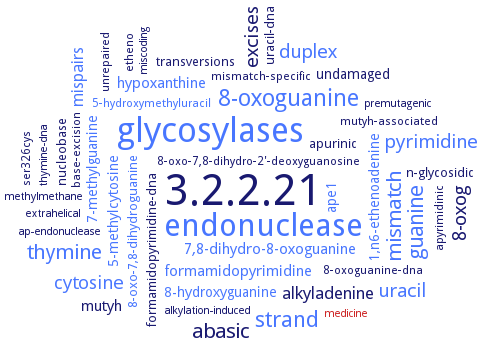3.2.2.21: DNA-3-methyladenine glycosylase II
This is an abbreviated version!
For detailed information about DNA-3-methyladenine glycosylase II, go to the full flat file.

Word Map on EC 3.2.2.21 
-
3.2.2.21
-
glycosylases
-
endonuclease
-
8-oxoguanine
-
strand
-
guanine
-
thymine
-
mismatch
-
abasic
-
pyrimidine
-
uracil
-
duplex
-
8-oxog
-
excises
-
cytosine
-
alkyladenine
-
mispairs
-
mutyh
-
7,8-dihydro-8-oxoguanine
-
formamidopyrimidine
-
hypoxanthine
-
7-methylguanine
-
ape1
-
5-methylcytosine
-
1,n6-ethenoadenine
-
undamaged
-
8-hydroxyguanine
-
8-oxo-7,8-dihydroguanine
-
formamidopyrimidine-dna
-
nucleobase
-
transversions
-
apurinic
-
uracil-dna
-
n-glycosidic
-
ser326cys
-
etheno
-
mutyh-associated
-
unrepaired
-
mismatch-specific
-
8-oxo-7,8-dihydro-2'-deoxyguanosine
-
base-excision
-
5-hydroxymethyluracil
-
apyrimidinic
-
8-oxoguanine-dna
-
premutagenic
-
alkylation-induced
-
ap-endonuclease
-
thymine-dna
-
medicine
-
miscoding
-
extrahelical
-
methylmethane
- 3.2.2.21
- glycosylases
- endonuclease
- 8-oxoguanine
- strand
- guanine
- thymine
- mismatch
-
abasic
- pyrimidine
- uracil
- duplex
-
8-oxog
-
excises
- cytosine
-
alkyladenine
- mispairs
-
mutyh
- 7,8-dihydro-8-oxoguanine
- formamidopyrimidine
- hypoxanthine
- 7-methylguanine
- ape1
- 5-methylcytosine
- 1,n6-ethenoadenine
-
undamaged
- 8-hydroxyguanine
- 8-oxo-7,8-dihydroguanine
-
formamidopyrimidine-dna
-
nucleobase
-
transversions
-
apurinic
-
uracil-dna
-
n-glycosidic
-
ser326cys
-
etheno
-
mutyh-associated
-
unrepaired
-
mismatch-specific
-
8-oxo-7,8-dihydro-2'-deoxyguanosine
-
base-excision
- 5-hydroxymethyluracil
-
apyrimidinic
-
8-oxoguanine-dna
-
premutagenic
-
alkylation-induced
- ap-endonuclease
-
thymine-dna
- medicine
-
miscoding
-
extrahelical
-
methylmethane
Reaction
Synonyms
3-methyladenine DANN glycosylase II, 3-methyladenine DNA glycosylase II, 3-methyladenine-DNA glycosidase II, 3-methyladenine-DNA glycosylase II, AAG, ALK, AlkA, AlkA protein, AlkA1, AlkA2, AlkD, alkylpurine-DNA-N-glycosylase, ANPG, deoxyribonucleate 3-methyladenine glycosidase II, DNA glycosylase, DNA-3-methyladenine glycosidase II, helix-hairpin-helix DNA glycosylase, m3A DNA glycosylase II, MAG, Mag1 protein, MPG, N-methylpurine-DNA glycosylase, TagII
ECTree
Advanced search results
Engineering
Engineering on EC 3.2.2.21 - DNA-3-methyladenine glycosylase II
Please wait a moment until all data is loaded. This message will disappear when all data is loaded.
D113N
-
the mutation results in a 100fold decrease in the single-turnover rate of 7-methylguanine excision relative to the wild type enzyme
R148A
-
the mutation results in a 100fold decrease in the single-turnover rate of 7-methylguanine excision relative to the wild type enzyme
D238N
N169A
-
ratio of 3-methyladenine/7-methylguanine is 29:1 for wild-type enzyme and 26:1 for mutant enzyme N169A, 30fold lower activity than wild-type enzyme. Expression of the N169A in Saccharomyces cerevisiae during methyl methanesulfonate exposure results in greater sensitivity, greater mutation induction following exposure to methyl methanesulfonate and more strand breaks in vivo
N169D
-
ratio of 3-methyladenine/7-methylguanine is 29:1 for wild-type enzyme, 100fold lower production of 3-methyladeine and no production of 7-methylguanine is detected with mutant enzyme N169D. When expressed in Saccharomyces cerevisiae, the N169D variant provides better protection against methyl methanesulfonate toxicity than wild-type enzyme. Fewer strand breaks in vivo are seen in the presence of the N169D variant following exposure to methyl methanesulfonate
N169S
-
ratio of 3-methyladenine/7-methylguanine is 29:1 for wild-type enzyme and 24:1 for mutant enzyme N169S, 30fold lower activity than wild-type enzyme. Expression of the N169S in Saccharomyces cerevisiae during methyl methanesulfonate exposure results in greater sensitivity, greater mutation induction following exposure to methyl methanesulfonate and more strand breaks in vivo
additional information
-
recombinant expression of enzyme and targeting to mitochondria or nucleus of primary astrocytes. Increasing enzyme activity significantly increases base excision repair kinetics in both the mitochondria and nuclei. Increased nuclear enzyme activity results in cell death in astrocyte cultures treated with methylnitrososurea


 results (
results ( results (
results ( top
top






